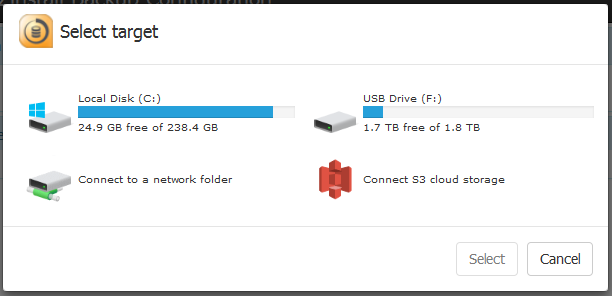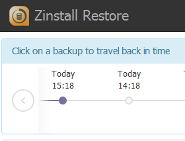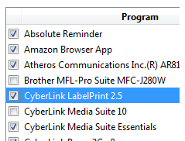Need a solid backup for your Server 2019, 2016, 2012 or 2008 R2?
Amazon AWS, combined with solid client-side software, is a great way to cover your bases and be able to recover everything in case of a disaster.
In this article, we’ll learn how to set up a full backup of your entire server to Amazon S3 Cloud storage. Not just files – we are talking about being able to recover the entire server, including installed software, its settings, profiles, accounts, shares and data.
Amazon S3 already serves many of its users as an impromptu backup solution, typically for some of the more important (designated) files. Amazon even provides command line tools to make automated file copy to S3 easier. However, it is in no way a complete backup product, and is not built as one; in itself, S3 is a Cloud storage “utility”, like power or tap water.
This tutorial demonstrates how to use a combination of Amazon S3 and dedicated server backup software to establish a powerful backup, which automatically protects your entire server, and – more importantly – can restore your entire server in case of disaster.
Further down the line, we’ll cover how to setup a hybrid backup, so that your backup is stored both in AWS and on your local storage, thus complying with the 3-2-1 rule of data protection (at least 3 copies, in at least 2 locations, with at least 1 off-site).
Of course, incremental backups are performed automatically: you don’t need to “babysit” your backup or to manage backup schedules and backup windows.
Most importantly, when disaster strikes, you can restore even to a completely different replacement server, even to different Windows version, even to different infrastructure (such as a Cloud-hosted replacement server) – including applications, DBs, settings, profiles, shares and all data.
Let’s get started.
To set up the backup, you will need two things – access to Amazon S3 storage, and backup software.
Here is what you need to do, in a nutshell (more details are available below):

So what happens now?
Zinstall FullBack Server will first make a full backup of your Windows Server. It will be safely stored in your Amazon S3 Cloud Storage.
This part takes a while, of course. The exact duration of “a while” depends on the amount of data on the server, and your upload speed.
Once the initial backup is complete, it will keep backing up any changes that happen on the server. So if you change a file, or install a new application, your backup will be updated accordingly. This is all done completely automatically. In fact, you probably won’t even feel it running.
Using a combination of file- and sector-based introspection, FullBack is quite efficient in handling just the changes that happen, and even protects the hard drive’s health, by minimizing the amount of I/O operations involved (this makes the drive live slightly longer). For example, if one of your users has a 10GB PST stored on the server, and causes 10MB worth of changes, the actual upload for that will be very close to 10MB – not the entire 10GB.
Of course, the real reason you have a backup is the restore part. How do you restore a single file that got misplaced? And how do you restore everything, including applications, if the server crashes? Read on to find out.
So one of your users was working on an important document, and now it’s gone for no apparent reason. If that document was stored on the user’s server-side share, fear not – that’s exactly why you have set up an automatic backup of your entire server! Here is what you do:

That’s it – your file is back and unharmed.
Don’t panic! You have a backup.
You will first need to determine where you are restoring that backup to. This could be a replacement physical server, a replacement virtual machine, a Cloud-hosted server (such as Amazon’s own EC2), or – if the original server’s hardware is intact – the same server you’ve had before, with a fresh hard drive.

The first step you have to do is to install Windows on the target server. With a FullBack Server Pro restore, you can choose to install a completely different Windows version. Even if the original server was, for example, Server 2008 R2, you can restore it to a Server 2019 deployment.
Once Windows is installed (and joined to your domain), you can proceed with the restore.
To do that, install Zinstall FullBack on the replacement server. Select your Amazon S3 as backup source, and follow the prompts for complete restore. When finished, just restart the server, and you’ll see all the applications, settings and files from your crashed computer.
What does not get restored?
While FullBack Server Pro is able to restore applications, settings, profiles, shares and all data, there are some things that it will not be able to recover automatically. Here is what is not restored:
What if you want to restore not to a physical server or local VM, but to a Cloud server instance – can that be done?
The short answer is “yes”, although there are some caveats to consider.
In terms the restore process itself, it is pretty much identical to restoring to a local server. Install Windows, run through the FullBack Server Pro restore process, get your apps and data back, make the final adjustments you need.
In fact, since you are using Amazon AWS anyway, you can spin up an Amazon EC2 server instance (Amazon’s hosted virtual server), and restore to it directly. This will be very quick, too, since the restore will happen inside the same Amazon datacenter (as long as you choose the same geographical location for your server as your S3 account). You can of course restore to non-Amazon Cloud servers as well.
The main caveat compared to local server is going to be connectivity. Your Cloud server is not automatically accessible from your network and is not automatically connected to your domain, so you will need to bridge the gap using SDN or VPN, and to make sure that your client machines are able to communicate with the new server.
With that said, restore to Cloud allows a truly fast recovery, without spending time on installing a local replacement, and works even if you do not actualyl have a local replacement. Plus, even if you do not have an immediate connectivity solution, sometimes just having the server available and running on the Cloud, with access to its data and environment, far outweighs the connectivity inconveniences. This is certainly something to consider.
In the setup overview above, we’ve glossed over the S3 configuration part. Here is what you need to know.
Where do I sign up for Amazon S3?
You can sign up for Amazon AWS right here. They have a 1 year “trial” free tier; after that, or once you exceed the limitations of that tier, you will start getting charged by Amazon, according to your storage usage.
For more info, check out the Getting Started with Amazon S3 guide
How do I connect my FullBack Server to my S3 account?
Once you have an S3 account, you will need to get the S3 credentials required for backup. Amazon calls those “Access Key” and “Secret Key”. Once you have them, enter them into the FullBack “S3 Storage” prompt, and you’ll be all set.
Amazon have a dedicated guide on retrieving those keys here.
In a nutshell, here is what you need to do:
You now have the Access Key and the Secret Key that you need in order to allow your FullBack Server backup to upload your backup to your Amazon S3 account. Note that Amazon will only show these keys to you once, and you will not be able to retrieve them again if you forget them (only create new ones). It is thus recommended to use the “Download .csv file” option below the keys, in order to download them as a file – or at least note them down in a secure location.
Great! You now have a solid Cloud backup of your Windows Server. Are we done?
On one hand, you are very well protected at this point. Amazon Cloud storage is best in class, and includes protection from hardware failure or software failure, which is transparent to you as a the client. However, for a truly complete backup, it is generally recommended to follow the 3-2-1 rule: 3 copies of your data, stored in 2 locations, 1 of them off-site.
You currently have 2 locations (your server and Amazon AWS), with one off-site (Amazon). Luckily, FullBack Server allows you to comply with the 3-2-1 rule by adding another backup target, independent of your Cloud backup.
Typically, the local backup would use local network storage (NAS / SAN). You could of course use other options as well; any storage where you can store files and have enough space, can be used as your additional backup target.
Another important benefit of using this kind of hybrid backup approach (on-premise + off-premise) is speed. In most recovery scenarios, your local backup is alive and well (as opposed to situations when you must have an off-site location, such as fires, floods etc.) It is much faster to restore from local storage than from the Cloud; having a local backup will allow you to be even more efficient in your restores, without sacrificing the resilience you get with off-site Amazon S3 backup.
Hybrid backup is really the best of both worlds.
Amazon S3 is one of the best Cloud storage solutions on the market. By using FullBack Server Pro and Amazon S3 together, you get a complete, automatic, always-on Cloud backup of your entire Windows Server, including all programs, settings and files.
It is extremely easy to set up. You do not have to connect any equipment to the server itself, or even remember that you have a backup. It is all automatic.
And when you accidentally delete a file, or when your server crashes, you will be able to recover efficiently and completely – and will thank yourself for taking the right precautions well in advance.